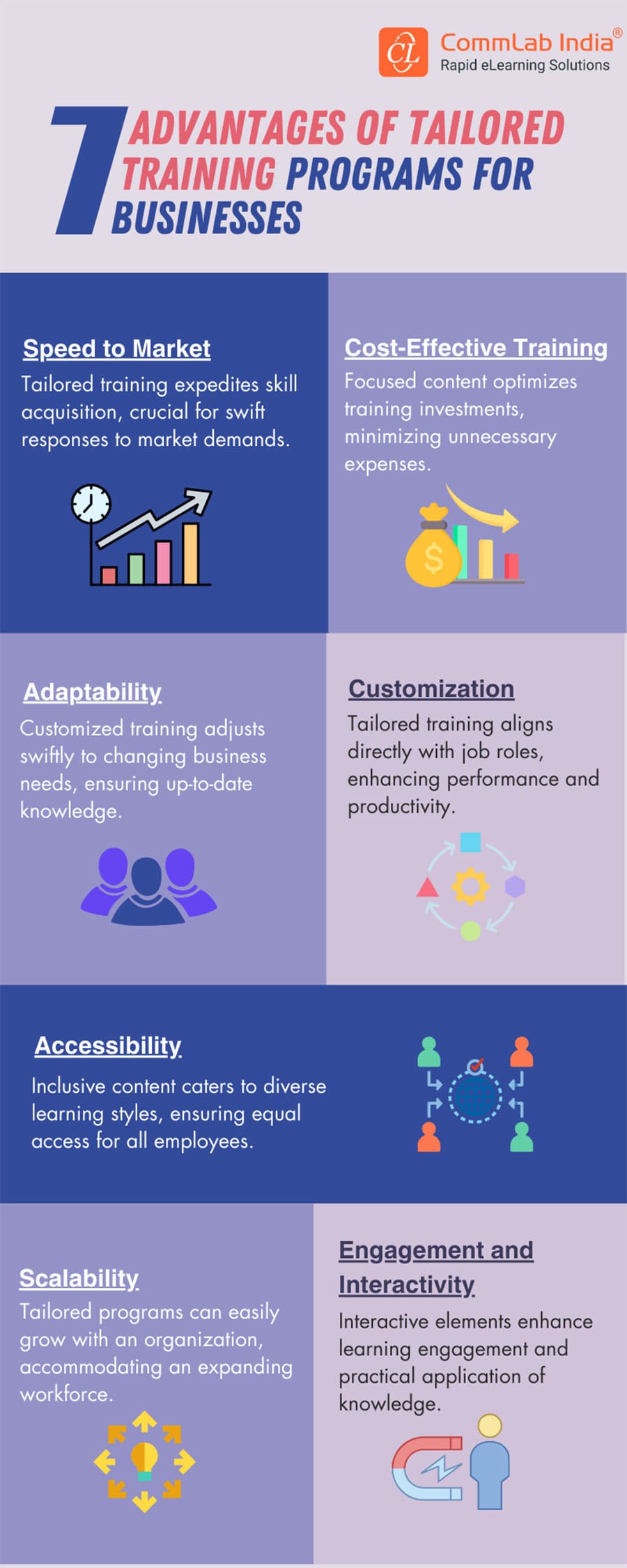7 Advantages of Tailored Training Programs for Businesses [Infographic]
![7 Advantages of Tailored Training Programs for Businesses [Infographic] 7 Advantages of Tailored Training Programs for Businesses [Infographic]](https://blog.commlabindia.com/hubfs/blogs/advantages-tailored-training-programs-infographic.jpg)
In today's competitive world, enabling employees to gain skills and the organization to meet business goals with off-the-shelf courses is like trying to race against a car on a bicycle. For maximum training impact and desired ROI, it's essential to understand the learners as well as match the pace of quickly changing market trends. This calls for continuous learning and development and organizations striving for success should invest in the growth and improvement of their employees as it is not just beneficial but also necessary. The best way to do so is by leveraging tailored training programs.
These programs are specifically designed keeping in mind the needs of individuals and teams. Customized training programs help ensure that the training aligns perfectly with the organization's goals and the learner's capabilities. In this blog, we will explore seven compelling benefits of tailored training programs and discuss five essential considerations to keep in mind when creating them.
Without further delay, let’s begin!
7 Advantages of Tailored Training Programs for Businesses
5 Things to Keep in Mind While Creating Tailored Training Programs
Identify Learning Objectives
Learning objectives are the foundation for course design and development. So it’s important to conduct a proper need analysis and identify the learning objectives. It is equally important to define them clearly as it helps you outline what you want to achieve with the training program. Also, it gives learners a fair idea about what they can expect from the course and how it aligns with their learning needs.
→ Download Now: How L&D And Business Can Align to Conquer The Future Of Work
Understand Your Learners
Knowing your learners is crucial for designing effective, learner-centric training programs. It includes their educational backgrounds, current roles and responsibilities, interests, and skill levels. Based on this information, you can easily tailor the learning pathways and content to match their needs. It will help you ensure that the courses assigned are relevant and impactful.
Select the Right Instructional Strategy and Delivery Method
Training your Gen Z workforce through PPTs or conducting in-office training for your on-the-go sales teams might fail to deliver the expected results. Based on your target audience, it’s important to select a relevant instructional design strategy and delivery method.
It facilitates a more effective, engaging learning experience for the employees. Some of the popular and high-impact instructional design strategies include microlearning, mobile learning, storytelling, scenario-based learning, video-based learning, and gamification.
Regularly Update Content
Training needs evolve with time and industry changes. So it’s essential to keep updating your training programs to stay relevant and ensure they continue to fulfill learner’s needs and meet your organization's objectives.
Assessment and Feedback
eLearning assessments and providing feedback is the final step to ensuring successful, effective training programs. Try to create a relevant assessment and feedback system to gauge the effectiveness of your tailored training programs. This allows for continuous improvement and helps fine-tune future programs.
To Sum It Up!
Tailored training programs are an important factor in ensuring effective employee development and organizational success. It handles various training elements like learner engagement, active participation, improved retention, and better knowledge application in a better way. By incorporating tailored training programs into their L&D strategy, organizations can tap into the potential of the employees and channel it toward desired outcomes. Here’s an eBook for you to learn more about how L&D and business can align for successful results.





![4 Reasons Why Blended Learning Can Change the Game [VIDEO]](https://blog.commlabindia.com/hubfs/Imported_Blog_Media/4-Reasons-Why-Blended-Learning-Can-Change-the-Game.jpg)

